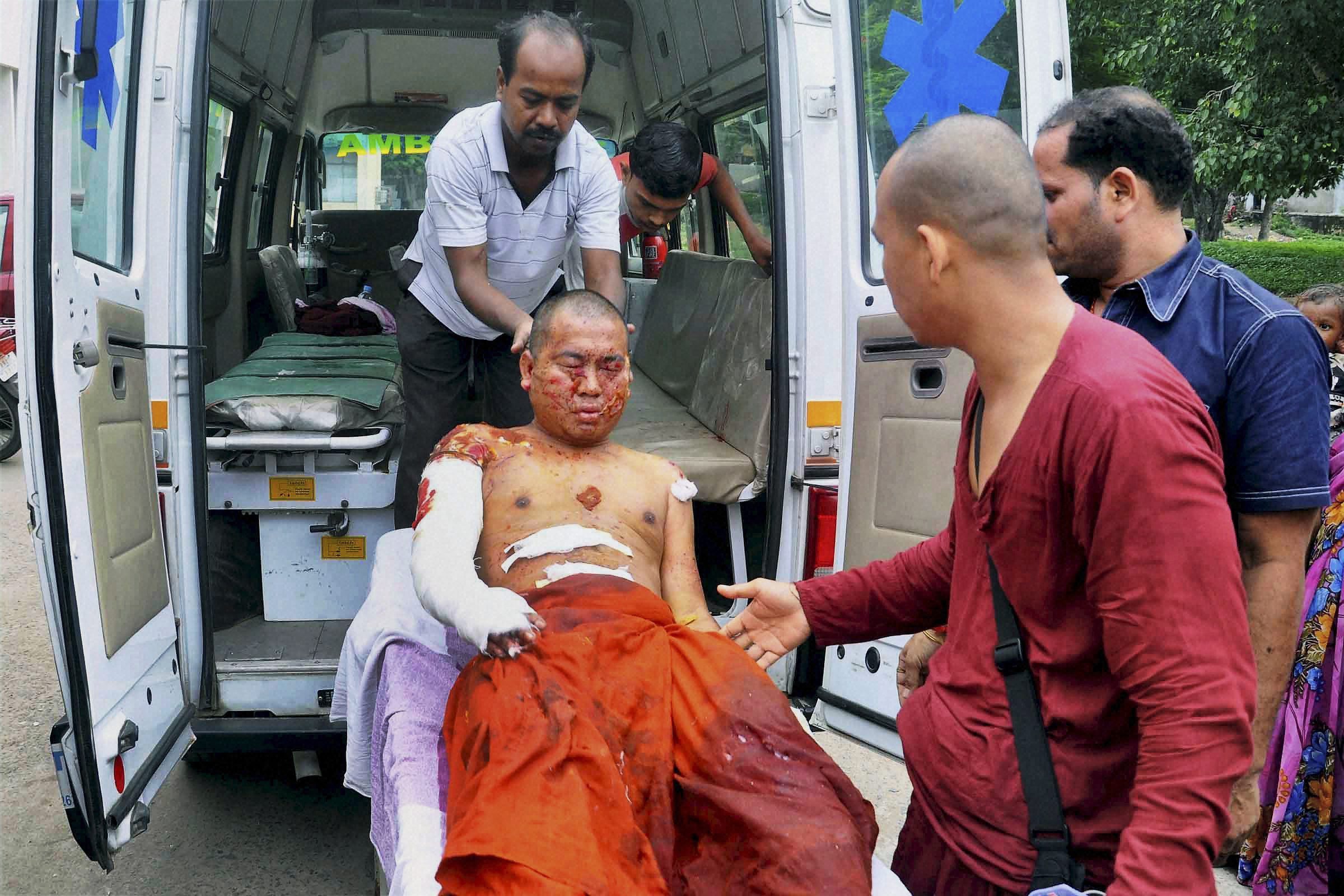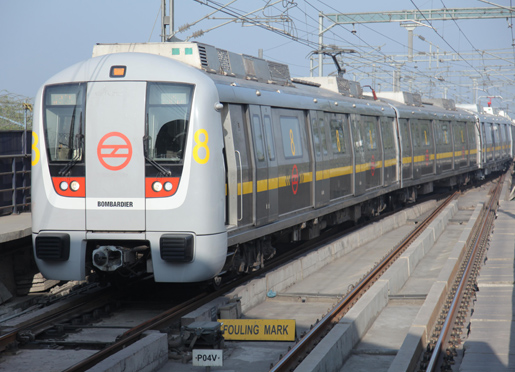BY Anumeha Yadav

AS VILLAGE pramukh Madhuben Shiayal finished addressing the meeting, a dozen koli men and a handful of women who had taken off time from weeding the bajri fields got up to go. The hot April sun blazed over Khared, a village in Mahuva taluka in Bhavnagar district of southern Gujarat. Unlike others, Natha Shiayal, an elder with a quiet demeanour, walked barefoot.
Shiayal is one of the five farmers who have gone barefoot the past two years to protest against the permit given to Nirma to build a cement plant in the catchment area of their village reservoirs. His village Khared is one of nine where the government handed over 4,415 hectares, including irrigable farmland, pastures and wetland, against the will of Gram Sabhas.
12,000 farmers marched 350 km to Gandhinagar when the Assembly was in session last month
Mahuva has since become the strongest voice of dissent in Gujarat, a state that otherwise claims a deep consensus over development and land use. Over 12,000 farmers from Mahuva walked 350 km to Gandhinagar when the Assembly was in session last month. These protests are key to understanding the sparring that erupted when Anna Hazare endorsed Narendra Modi’s model of rural development.
“We will go again and again if they don’t listen,” says Dhakuben Bariya. Surrounded by her grandchildren in her hut in Gujarda village, she narrates her padyatra to Gandhinagar, walking over 10 hours a day for 14 days. She describes being detained by the police at Sarkhez police station on the outskirts of Ahmedabad, while protesting in February 2010.
And before that, at Sola police station in 2009. Learning not to be intimidated by police batons is not the only thing 60-year-old Dhakuben has inculcated in two years of fighting for her 5-bigha plot. Hers was one of the 3,000 families that laboured three months to dig a km-long channel between Malan and Samadhaliya last June when the state government refused to do so to coerce Mahuva’s farmers to give up their demands.

Photos: Vijay Pandey
“They stopped work on the spread channel connecting the two reservoirs saying it was not a priority. When I went to Gandhinagar to meet Irrigation Minister Nitin Patel in April, he tried to barter with me saying if we did not take our PIL to the Supreme Court, he would allow the work on the canal to go on,” said Kanubhai Kalsaria, a three-time BJP MLA from Mahuva. Kalsaria led Mahuva farmers to pool in their resources and build a waterway.
When TEHELKA contacted Patel, he denied Kalsaria’s allegation of arm-twisting farmers but declined to reveal why the irrigation department abandoned work on this Rs 3.74 crore, 5 km-long channel meant to bring water to five villages.
Ironically, farmers in Mahuva are struggling to retain the benefits that accrued to them from state interventions. There are 543 villages on the limestone-rich Saurashtra coast that struggle for drinking and irrigation water because of a problem of rising salinity in the soil. It is here that the Gujarat High Court intervened last year after RTI activist Amit Jethwa was shot dead outside the court in July, three weeks after he filed a PIL accusing BJP MP Dinu Solanki of operating illegal limestone mines.
Following recommendations of two state committees in 1976 and ’78, the Irrigation Department’s Salinity Ingress Prevention Cell (SIPC) built three check dams in Mahuva between 1998 and 2002. This helped replenish groundwater in 30 villages. Much to the farmers’ disappointment, the government handed over land containing the catchment area of these reservoirs in the land allotted to Nirma in 2003 to build a cement plant.
“Earlier we could grow only one kharif crop, and my sons had to go to Dholka to look for work. After the check dams were built, we were able to grow cotton, groundnut, bajri, wheat and maize all in one year. Our income has doubled,” says Shiayal. “How can the government allow a cement plant on the same check dams?”
Long-drawn court battles have made the churning in Gujarat more visible even to an otherwise insulated middle class. “Stop selling Gujarat!” said Chief Justice SK Mukopadhyaya rebuking the government while presiding over the Mahuva case in 2010. This February, the high court issued a notice to the Adani Group’s SEZ off the Kutch coast when farmers from Mundra filed a petition that their pastureland had been usurped, violating Gram Sabha resolutions.
It is tenuous struggles such as these that the civil society and Gandhians jumped to defend following Hazare’s endorsement of Modi’s Gujarat. “This government is an expert in melas and rallies and trumpeting its own name. Outsiders hear only the trumpets starting, they do not listen to what happens when the music dies down,” lamented Chunnilal Vaidya, a 93-year-old Gandhian based in Ahmedabad.

Photos: Anirudh Dhabi
Gujarat has been one of the five top per capita income states in India since independence. In this industry-driven revenue-rich state, villages have also prospered because of a robust rural cooperative movement and strong farmers’ lobby in the ’60s. But the current government’s stance of suppressing any dissent and feeding off superficial endorsements like Hazare’s has civil society activists worried. “Hitler’s machinery is like child’s play compared to Modi’s PR work; they send out thousands of SMSes and mails the second anything breaks out. I have great respect for Hazare’s work but the ground reality in Gujarat is different from what Modi portrays,” says Ahmedabad-based classical dancer Mallika Sarabhai who has declared that she will distance herself from the Lokpal movement unless Hazare retracts his statement.
Beyond the stance taken by activists, what is happening in Gujarat reflects in the numbers. According to the study ‘India State Hunger Index’ by The International Food Policy Research Institute (IFPRI), a US-based research organisation, Gujarat with its 9 percent growth rate does worse than states like Uttar Pradesh, Rajasthan and Assam in feeding its poor. On average, a person living in Gujarat gets 1,632 kcals per day (The calorie norm Planning Commission uses is 2,400 in rural areas and 2,100 in urban). By the government’s own admission, one out of two children in Gujarat is underweight; 80 percent adolescent girls have anaemia.
Academics say this paradox of hunger amid riches is not explained by the farmers’ shift to cash crops or a shift from agriculture to industry. But it reveals how Gujarat’s rural poor slip through the cracks.
“National Sample Survey data shows that a male labourer in rural Gujarat earns Rs 68 and females get Rs 58, much lower than the national average. How will people buy food when they don’t have the money?” asks Indira Hirway, economist and co- author of Gujarat’s Human Development Report, 2004.
It is tribals in the state’s eastern belt — the poorest section of Gujarat’s population — who are the most vulnerable. Since 2008, Manji Mogha Damorh of Shankarpura village in Jhalod taluka of Dahod, a tribal- dominated district, has watched a son and a daughter in their 20s die of silicosis, a respiratory illness they contracted while working at less than minimum wages in Godhra’s mineral factories.
He has mortgaged his 5 bigha to raise Rs 60,000 for the treatment of his two surviving sons, who also have this fatal condition. “I try to work on others’ farms but this land is undulating and does not support much,” says Damorh. He brings out from his hut the MGNREGA job card issued to him in 2006, one of the few proofs of his entitlements from the state government. It records only the date of issue, 27 February 2006: All other entries are empty.
In April 2010, the Modi government was found diverting MGNREGA funds to other departments
In April 2010, the Modi government was found diverting MGNREGA funds to other departments. Union Rural Development Minister CP Joshi then set up a probe in July to inquire into this. “They see MGNREGA as a source of Central funds and undermine the scheme. Tribals in Narmada, Dahod, Panchmahal are forced to migrate and work at less than minimum wage,” says Paulomee Mistry of the 15,000- strong Gujarat MGNREGA workers’ union, which first reported that a circular diverting MGNREGA funds was doing the rounds after a meeting chaired by the CM.
It is a similar attitude with other pro-poor legislations. Five months ago, the Saxena Committee on Forests Rights Act found the state has one of the highest rates of rejection of individual forest rights claims. Of 1,82,568 claims, the government had arbitrarily rejected over 75 percent. “They say they are relying on satellite imagery, but this is poorly designed. They have done even less work on acknowledging community forests rights that would enable Adivasis to support themselves on minor produce like bamboo,” says Ashish Kothari, a member of the committee.
One of this government’s flagship pro-poor interventions has been to bring Narmada waters to Gujarat farmers. But here too, it has failed to build 75 percent of the canals and distributaries without which the water does not reach small farms . Farmers are in a bind as they watch Narmada waters flow by but when they try tap it, they are treated like thieves. “Officials seized the pump and fined me Rs 10,000, saying it is illegal to draw this water,” laments Bhechra Bharwad in Ganeshpur village in Surendranagar district. Not too different from the kind of mirage that this government has lured others into.
Anumeha Yadav is a Senior Correspondent with Tehelka
anumeha@tehelka.com




